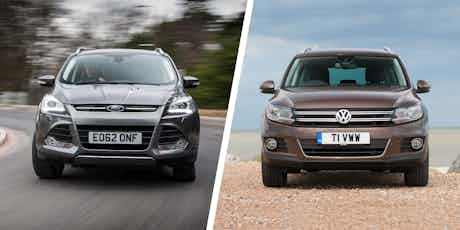Ford Kuga vs Volkswagen Tiguan: compact crossovers compared
May 05, 2015 by carwow staff

Fans of soft-roaders have plenty to shout about just now. The market is brimming with everything from well-equipped budget options to upmarket premium offerings.
Somewhere in the middle of the two extremes sit the Ford Kuga and Volkswagen Tiguan. Both cars are popular, but which of the two big hitters should you buy?
We’ve compared them side-by-side to deliver the definitive verdict.

Styling
The Kuga is one of the few Ford models that hasn’t yet adopted the new family front end. So – for the time being, at least – it lacks the Aston Martin-inspired face common to the Fiesta, Focus and Mondeo. It’s still distinctive, though, and different enough from everything else in its class not to get lost in a car park.
As is the case with most Volkswagen products, the focus of the Tiguan is on offering buyers a simple, sturdy and contemporary design. There’s nothing groundbreaking in styling terms, but every panel points towards quality production.
Volkswagen has built its brand around these values, and it’s clearly not taking any risks.

Interior
Much of what we said about the exterior applies when you hop inside. The Tiguan’s dash is simple, well-thought out and perhaps a little bit boring, but the Kuga’s cabin is rather more quirky. The Ford’s interior divides opinion much more than the outside does, but if you’ve driven or owned another recent car from the same family you’ll get used to it soon enough.
What’s perhaps a little harder to become acquainted with is the quality of some of the plastics. Some areas – particularly lower down – are scratchy and feel cheap, and they aren’t a patch on the Tiguan. Some of the Kuga’s ergonomics could be better too. The Sony Audio System found in higher spec models is a mess of buttons, which not only look untidy but make it tricky to use. Elsewhere, though, Ford has got the basics right, with the major controls well-placed and feeling good in the hand.
When it comes to cabin space, neither car will leave you wanting. Each has room for four adults, and the high seating positions in both allow for better views out. The Tiguan’s boot, at 470 litres, is 64 litres more capacious than the Kuga’s. Yet the Kuga is more practical if you’re laden with shopping, since a sensor beneath the rear bumper lets you open the tailgate with a wave of your foot.

Engines
Buy a Tiguan and you can take your pick of six engines, compared to four for the Kuga. You can choose between petrol and diesel in each instance, with the most economical in either car being 2.0-litre turbo diesels giving 53.3mpg.
Performance is broadly the same across the board: the Kuga hits 62mph from a standing start in 10.7 seconds; the Tiguan does it in 10.3 seconds.
Most testers agree that the diesel engines in both cars are smooth enough, but can be clattery when accelerating hard.
Elsewhere in the range, the 1.5-litre EcoBoost petrol motor in the Kuga is described as “slightly strained” by some testers, but achieving 0-62mph in less than 10 seconds isn’t to be sniffed at.
That said, if performance is your thing, the Tiguan is the car for you. Combine a 210hp 2.0-litre turbo petrol with four-wheel drive in the top spec R-Line model and you’ll crack 0-62mph in just 7.8 seconds. Sadly the old Kuga’s performance option – the brilliant 2.5-litre five cylinder turbo derived from the previous Focus ST – hasn’t made it into the current car.

Driving
The new Kuga has been softened as part of its upgrade, so it feels more comfortable and refined on long journeys. In most cases, it’s better than the Tiguan, which despite insulating wind and road noise well, can feel a little too firm.
Both cars are too tall and heavy to maximise the enjoyment you’ll get from throwing them along a twisty road. Neither is ponderous, but the Mazda CX-5 is the best bet in this class if fun is your thing.

Value for money
If price is the deciding factor, go for the Kuga. The 1.5-litre turbo petrol engine in Zetec spec is almost £1,000 cheaper than the entry-level Tiguan, which also lacks the generous equipment levels of the Ford. Cruise control and 17-inch alloy wheels are both standard on the Kuga, but optional extras on the base Tiguan.
At the other end of the scale, the priciest Kuga is more expensive than the equivalent Tiguan – and less powerful too. But take kit into account (the top-spec Kuga has leather seats as standard, which are a £1,680 option in the Volkswagen) and the extra outlay starts to justify itself.
The Tiguan should hold it’s value better than the Kuga. A 2014 study by Glass’s motoring guide suggested that Volkswagens hold on average three per cent more of their value than Fords do.
Verdict
If we based our verdict on wowscores, then the overall winner is a close run thing. The Tiguan just edges ahead of the Kuga, with scores of 7.1 and 6.8 respectively. Thanks to the higher quality cabin, the broader range of engines and impressive residuals, the Volkswagen certainly makes sense.
Don’t discount the Kuga altogether, though. It’s more comfortable and better-equipped than the Tiguan.
Each has its own merits, and the choice will depend very much on your own priorities, but we would push most buyers towards the Tiguan, by just the slimmest of margins.















